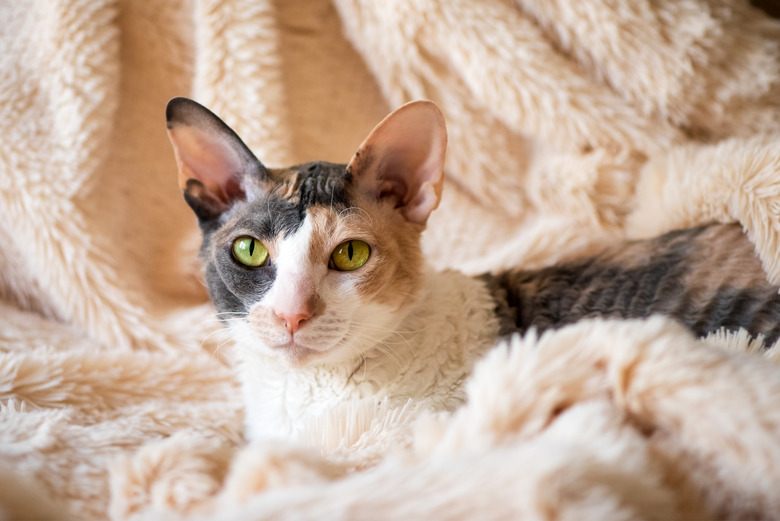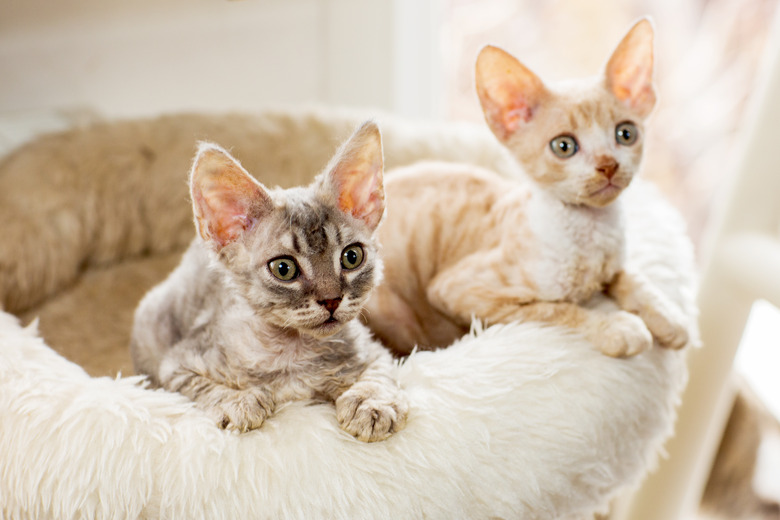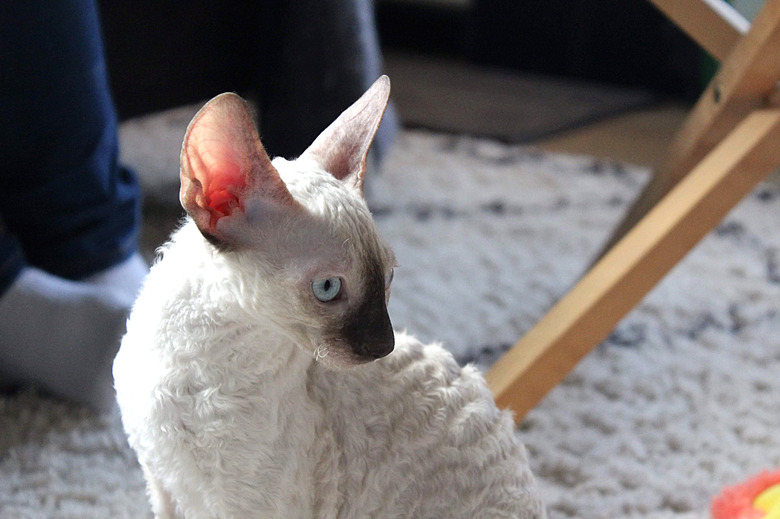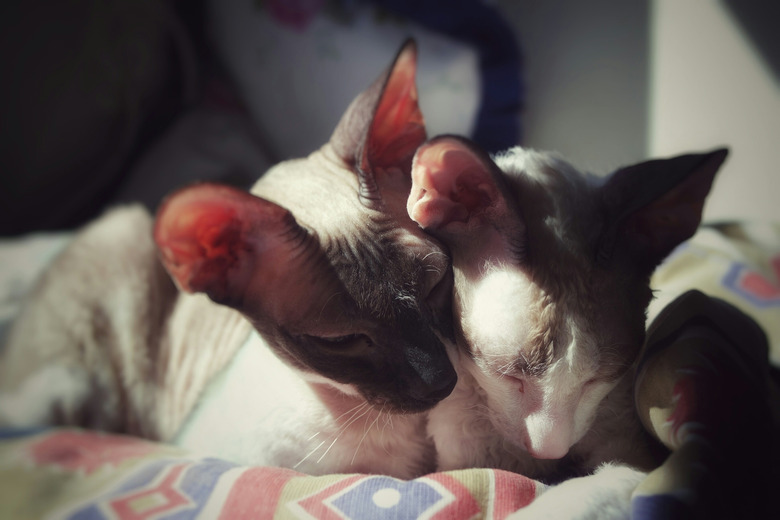Cornish Rex Cat Breed Characteristics
Cornish rex cat quick facts
Cornish rex cat quick facts
Length: 12 – 16 inches
Weight: Females: 5 – 7 pounds, Males: 6 – 9 pounds
Lifespan: 9 – 13 years or more
Coat length: Short
Coloring: All coat colors and patterns
Grooming needs: Low
Friendliness: Breed alone is not an accurate predictor of individual cats' personalities. However, Cornish rex cats are generally regarded as affectionate and active.
The Cornish rex cat, also nicknamed the "feline version of a whippet" and "feline invaders from outer space," are fun, active cats with a unique and elegant appearance. These medium-sized cats are known for their playful antics and they love being an active part of the family. While some think these curly-coated cats are hypoallergenic due to their short, fine fur, this is unfortunately not the case. They do shed less than other breeds, but their short coat means they must be kept as indoor cats. Consider the breed's personality and care requirements to make sure the Cornish rex will be a good fit for your family.
Cornish rex cat history
Cornish rex cat history
The Cornish rex breed originated in Cornwall, England in 1950 when a tortoiseshell barn cat named Serena gave birth to a litter of kittens, one of which had a curly coat. This was the first Cornish rex kitten and he was named Kallibunker. As Kallibunker matured, more differences became apparent, including his large ears, egg-shaped head, long legs, and thin bone structure.
The pet parent, Nina Ennismore, later bred Kallibunker back to his mother and the resulting litter contained some curly-coated kittens. Geneticists determined that the curly coat is a recessive trait, so both feline parents must have at least one copy of the recessive gene. They later determined that the gene for the new breed is different than the one that causes the curly or wavy coat in the Devon rex cat breed.
The first Cornish rex cats were outbred to increase the gene pool and give the breed a strong foundation. Some cat breeds that were used include:
- American shorthairs
- British shorthairs
- Havana browns
- Russian blues
- Siamese
Cornish rex cats were brought to the United States in 1957 and the breed was accepted into the Cat Fanciers' Association (CFA) in 1964.
Cornish rex cat personality
Cornish rex cat personality
Cornish rex cats are incredibly active and social. The breed is quite athletic despite the appearance of their long, thin legs, and they enjoy running, jumping, and playing. The cats love a game of fetch or may entertain themselves by tossing toys into the air.
They enjoy people and prefer to spend their time with the family. This is not a good breed to have if you live alone and spend long hours working and traveling. The Cornish rex cats will do well with children and with any other pets you may have in the household.
Cornish rex cat lifespan and health issues
Cornish rex cat lifespan and health issues
A healthy Cornish rex cat receiving proper care can have a long lifespan and live well into their teens, reaching an age of 13 years or more. They are generally a very healthy breed, but they do have a few health problems to be aware of.
The primary concern for Cornish rex cats is due to their very short coat. The Cornish rex coat has dawn and awn hairs but does not have guard hairs, which means they have little protection against cold and wet. It also leaves them susceptible to dermatological problems such as sunburn. These cats should be kept indoors. If you do allow them out on an enclosed patio, be aware of the risk of sunburn.
There are also some genetic health problems that affect this breed of cat. Cats may develop a heart disease called hypertrophic cardiomyopathy. Some cats are also more prone to patellar luxation, a condition that causes the kneecaps to move out of position. Deafness is a concern in pure white Cornish rex cats. Responsible breeders will have their cats examined regularly to check for these conditions and will stop breeding cats found to carry hereditary diseases.
Cornish rex cat grooming and care
Cornish rex cat grooming and care
The short, soft, curly coat is one of the distinguishing features of the Cornish rex cat breed. They do shed, although not as much as many other breeds. Brushing isn't generally necessary; however, you will want to bathe the cat occasionally. This is because their short coat isn't able to absorb all of the oil produced by the skin. Use a gentle shampoo formulated for cats.
Other regular grooming tasks include:
- cleaning the cat's ears
- trimming the cat's nails
- brushing the cat's teeth with a veterinarian-approved toothpaste
Feed high-quality, commercial cat food in the amount recommended by your veterinarian. Many Cornish rex cats may overeat, so avoid free feeding. Provide fresh drinking water at all times. Cornish rex cats should be kept indoors as their coat does not provide the needed protection to survive outdoors. Take your cat to see the veterinarian for regular check-ups and keep them up-to-date on all of the recommended vaccinations.
Welcoming a new cat into your home
Welcoming a new cat into your home
Before you bring a Cornish rex kitten or cat into your home, make sure the environment is safe for your new feline friend. The Cornish rex is an intelligent and active breed, so take the time to cat-proof the home. Remove or secure any dangerous items, such as toxic plants. Make sure you have plenty of cat toys, a cat tree, and a scratching post so that the cat can be active without damaging your furniture. Consider a window seat and wall-mounted cat furniture to give your cat more entertainment opportunities.
When you introduce your new cat to their new home, start by keeping them in a single room. This gives them an opportunity to get used to the new sights and smells. Set up the room with everything your cat will need including:
- cat food and water
- litter box
- plenty of toys
Spend plenty of time with your new cat and introduce toys and offer to play. The Cornish rex breed tends to be quite social, so your new cat will likely warm up to you quickly. Don't rush the process though. Allow your new cat to explore at their own pace and let them decide when they are ready to be petted or start playing.
If you have children or other pets in the home, make sure to introduce them to the new cat. This ensures the animals have a positive experience and your cat has a safe room to relax if they get overwhelmed. Once your cat is comfortable, you can open up the door and allow them access to more of the house. Before you know it, your Cornish rex cat will be an active and playful member of the family.



